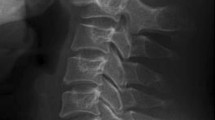Abstract
Introduction
Osteogenesis imperfecta (OI) is an inheritable disorder of bone development caused by defective collagen synthesis. The attendant basilar impression or secondary basilar invagination is uncommon but can be devastating.
Clinical materials and methods
Fifty-two patients with osteochondrodysplasia (28 with OI, six with Hajdu-Cheney syndrome, six with Paget’s disease, and 12 with spondyloepiphyseal dysplasia) with basilar impression were evaluated between 1985 and 2005. The male/female ratio in this cohort was 1:1. The mean age at presentation was 12.2 years.
Symptoms
Symptoms and signs included headache, lower cranial nerve dysfunction, dysphagia, respiratory embarrassment, weakness, and ataxia.
Treatment
In the earlier part of the series (1985–1995), all patients with hydrocephalus were shunted and a ventral transoral decompression made for ventral compression of the pontomedullary junction followed by a dorsal occipitocervical fusion. As a result of this evaluation, it was felt that most patients would benefit by early bracing after the hydrocephalus was shunted if it existed. However, 20% of patients still required an anterior ventral decompression and the occipitocervical fusion.
Results
The results showed that the fusions were stable but over a period of time, there was progressive forward bending with osteogenesis imperfecta as well as with the Hajdu-Cheney syndrome. All patients with spondyloepiphyseal dysplasia had a good strong stable fusion which stood the test of time.
Conclusion
In conclusion, we feel that early intervention with occipitocervical bracing can prevent the progressive march of significant basilar impression which leads to mortality.



Similar content being viewed by others
References
Ades LC, Morris LL, Haan EA (1993) Hydrocephalus in Hajdu-Cheney syndrome (letter). J Med Genet 30:175
Brennan AM, Pauli RM (2001) Hajdu-Cheney syndrome: evolution of phenotype and clinical problems. Am J Med Genet 100:292–310
Chandy MJ, Mohammed SH (1991) Osteogenesis imperfecta and basilar impression (letter). Br J Neurosurg 5:221–223
Cheney WD (1965) Acro-osteolysis. AJR 94:595–607
Cole WG (1993) Etiology and pathogenesis of heritable connective tissue diseases. J Pediatr Orthop 13:392–403
Diaz LA, Lippe K (1985) Acute extradural hematoma following trivial trauma in a case of osteogenesis imperfecta. Neurochirurgia 28:180–181
Faure A, David A, Moussally F, Khalfallah M, Jacquemont S, Hamel O, Conti M, Hamel A, Raoul S, Robert R (2002) Hajdu-Cheney syndrome and syringomyelia. J Neurosurg 97:1441–1446
Gertner JM, Root L (1990) Osteogenesis imperfecta. Orthop Clin North Am 21:151–162
Hajdu N, Kauntze R (1948) Cranio-skeletal dysplasia. Br J Radiol 21:42–48
Harkey HL, Crockard HA, Stevens JM, Smith R, Ransford AO (1990) The operative management of basilar impression in osteogenesis imperfecta. Neurosurgery 27:782–786
Hunt TE, Dekaban AS (1982) Modified head-neck support for basilar invagination with brain-stem compression. J Can Med Assoc 126:947–948
Kawamura J, Matsubayashi K, Ogawa M (1981) Hajdu-Cheney syndrome. Report of a non-familial case. Neuroradiology 21:295–301
Kawamura J, Miki Y, Yamazaki S, Ogawa M (1991) Hajdu-Cheney syndrome: MR imaging. Neuroradiology 33:441–442
McAllion SJ, Paterson CR (1996) Causes of death in osteogenesis imperfecta. J Clin Pathol 49:627–630
Menezes AH (2006) Editorial: osteogenesis imperfecta. J Neurosurg 105:359–360
Murray LW, Rimoin DL (1988) Abnormal type II collagen in spondyloepiphyseal dysplasias. Pathol Immunopathol Res 7:99–103
Pauli RM, Gilbert EF (1986) Upper cervical cord compression as cause of death in osteogenesis imperfecta type II. J Pediatr 108:579–581
Pozo JL, Crockard HA, Ransford AO (1984) Basilar impression in osteogenesis imperfecta. A report of three cases in one family. J Bone Joint Surg (Br) 66:233–238
Pozzati E, Poppi M, Gaist G (1983) Acute bilateral hematomas in a case of osteogenesis imperfecta congenita. Neurosurgery 13:66–68
Rao S, Patel A, Schildhauer T (1993) Osteogenesis imperfecta as a differential diagnosis of pathologic burst fractures of the spine. A case report. Clin Orthop Rel Res 289:113–117
Sayre MR, Roberge RJ, Evans TC (1987) Nontraumatic subdural hematoma in a patient with osteogenesis imperfecta and renal failure. Am J Emerg Med 5:298–301
Sawin PD, Menezes AH (1997) Basilar invagination in osteogenesis imperfecta and related osteochondrodysplasias: medical and surgical management. J Neurosurg 86:950–960
Sillence D (1981) Osteogenesis imperfecta: an expanding panorama of variants. Clin Orthop Rel Res 159:11–25
Smith R (1986) Osteogenesis imperfecta. Clin Rheum Dis 12:655–689
Tanaka T, Yamazaki Y, Mii K, Suwa T, Yada K (1996) Syringomyelia with basilar impression in osteogenesis imperfecta. Acta Neurochir 138:888–889
Tanimoto A, Tamaki N, Nagashima T, Nakamura M (1996) Syringomyelia associated with Hajdu-Cheney syndrome: Case report. Neurosurgery 39:400–403
Williams B (1977) Foramen magnum impaction in a case of acro-osteolysis. Br J Surg 64:70–73
Wycis HT (1944) Basilar impression (platybasia). A case secondary to advanced Paget’s disease with severe neurological manifestations. Successful surgical result. J Neurosurg 1:299–305
Author information
Authors and Affiliations
Corresponding author
Rights and permissions
About this article
Cite this article
Menezes, A.H. Specific entities affecting the craniocervical region. Childs Nerv Syst 24, 1169–1172 (2008). https://doi.org/10.1007/s00381-008-0602-z
Received:
Published:
Issue Date:
DOI: https://doi.org/10.1007/s00381-008-0602-z




